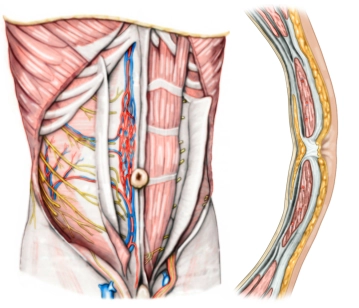Superficial Layer
The superficial layer of the abdominal wall is formed by the skin and the underlying fat tissue (panniculus adiposus).
Middle Layer
The middle layer consists of the anterior and posterior abdominal muscles and their respective fasciae.
Anterior Abdominal Musculature and Rectus Sheath
The anterior abdominal muscles include three very flat muscles and the rectus abdominis muscle:
• The flat muscles radiate ventrally medially into the rectus sheath and insert into it via a flat tendon (aponeurosis). From outside to inside, the following muscles are found:
• External oblique muscle: Dorsally, it originates from the thoracolumbar fascia and the lower 7 ribs and extends as the anterior layer of the rectus sheath to the median linea alba and the iliac crest of the pelvis. Its fibers run obliquely from cranial lateral to caudal medial.
• Internal oblique muscle: It extends from the linea alba to the iliac crest and to the anterior edge of the pubic bone. Its fibers also run obliquely from cranial medial to caudal lateral (continuing the external oblique muscle of the opposite side). Both muscles thus form an oblique cross in the anterior abdominal wall. Above the arcuate line, it radiates into the anterior and posterior layers of the rectus sheath, below the arcuate line into the anterior layer.
• Transversus abdominis muscle: Its fibers run from the thoracolumbar fascia or the lower costal cartilages and the pelvis to the linea alba anteriorly. In the upper anterior abdominal wall, it primarily forms the posterior layer of the rectus sheath. Below the arcuate line, it forms the anterior layer with the oblique abdominal muscles. The posterior wall of the 3 muscles is formed by the transversalis fascia.
• The rectus abdominis muscle originates bilaterally from the cartilage of the 5th to 7th ribs and attaches to the pubic bone near the pubic symphysis. The long muscle is divided into several bellies by tendinous intersections ("washboard abs"). Inconsistently, the small pyramidalis muscle is found caudally in front of the rectus abdominis, which tenses the linea alba. The rectus sheath is thus a tendinous canal of the flat abdominal muscles, containing several vessels and nerves (superior and inferior epigastric arteries and veins, intercostal nerves 5-12) alongside the rectus abdominis and pyramidalis muscles.
For flexion and rotation of the trunk as well as for the abdominal press, the anterior abdominal wall is tensed in the described manner by the two oblique abdominal muscles (external and internal oblique muscles, oblique cross) and the rectus abdominis and transversus abdominis muscles (straight cross).
The cremaster muscle is a branch of the internal oblique and transversus abdominis muscles. It forms a muscular sheath around the spermatic cord and can pull the testicle cranially (cremaster reflex).
Dorsal Musculature
The main dorsal muscle of the abdominal wall is the quadratus lumborum muscle, which extends below the transversus abdominis muscle from the lowest rib and the costal processes of the lumbar vertebrae to the iliac crest.
Deep Layer
The deep layer of the abdominal wall is formed by the transversalis fascia. It is found on the inner side of the rectus and transversus abdominis muscles as the innermost connective tissue layer (only separated from the free abdominal cavity by the peritoneum) and is fused with the arcuate line and the inguinal ligament. Laterally caudally, the deep inguinal ring is located as an entry point into the inguinal canal.
Blood Supply and Innervation
The arterial supply is divided according to the listed layers of the abdominal wall:
The superficial and middle layers are supplied by
• the caudal posterior intercostal arteries (including the subcostal artery),
• the superficial epigastric artery,
• the superficial circumflex iliac artery, and
• the external pudendal artery.
The deep layer is supplied by
• the lumbar arteries,
• the inferior epigastric artery,
• the deep circumflex iliac artery, and
• the iliolumbar artery.
The venous blood of the abdominal wall drains through veins (primarily → inferior vena cava), which are named according to the arteries:
via the superficial epigastric vein (→ great saphenous vein) and via the inferior epigastric vein (→ external iliac vein). Only the venous blood reaches the superior vena cava via the thoracoepigastric veins and the azygos and hemiazygos veins.
The innervation of the abdominal wall is provided by intercostal nerves and branches of the lumbar plexus:
• The lower intercostal nerves (including the subcostal nerve) supply, as described, the external oblique and rectus abdominis muscles.
• From the lumbar plexus, the iliohypogastric nerve innervates all anterior abdominal wall muscles, the ilioinguinal nerve also innervates all anterior abdominal wall muscles except the rectus abdominis muscle, and the genitofemoral nerve supplies the transversus abdominis muscle.
The iliohypogastric and ilioinguinal nerves also run between the muscles they innervate to the skin of the anterior abdominal wall.
The lymphatic drainage of the anterior abdominal wall occurs cranially above the navel (into the axillary and parasternal nodes), caudally below the navel (into the superficial inguinal and iliac nodes). From the lateral abdominal wall, lymph flows to the lumbar nodes.
